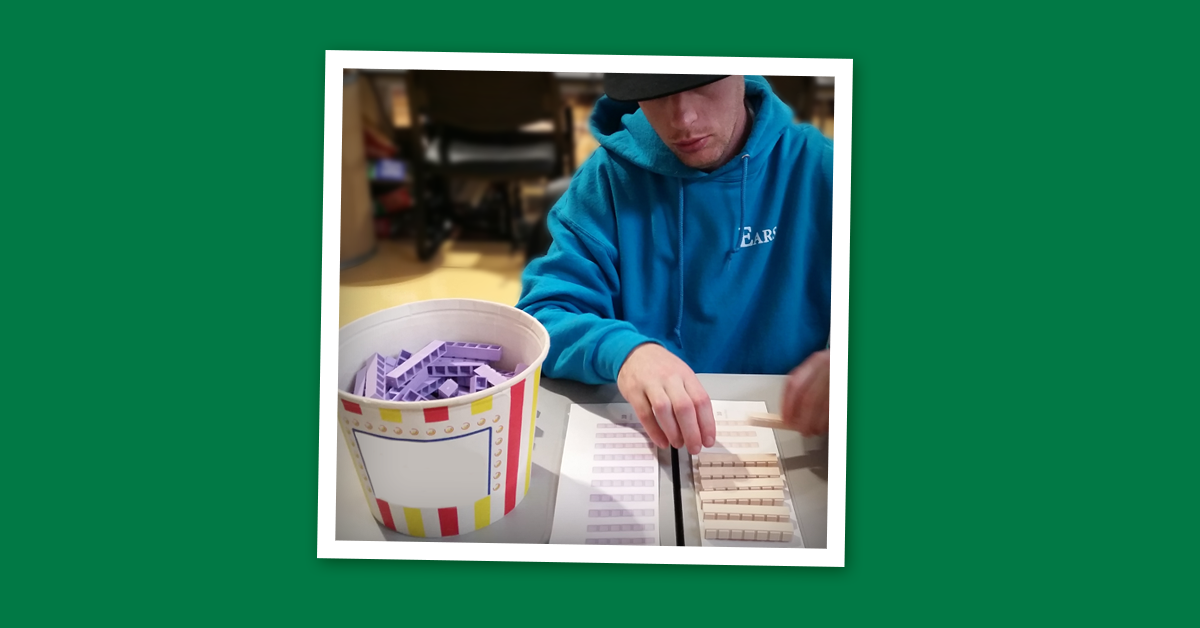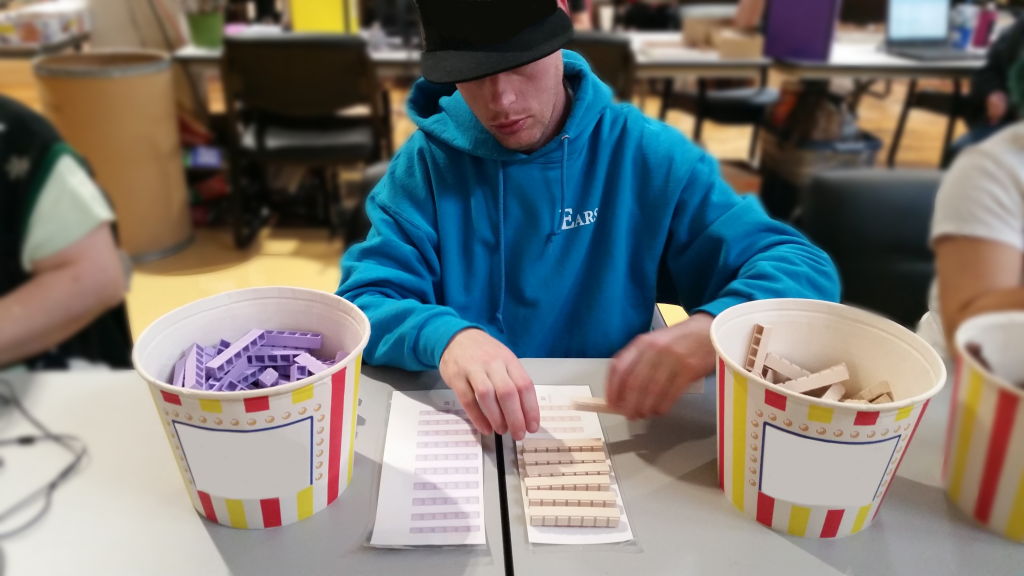Who Puts the Blocks Together for the First Time?

When you get your Math-U-See blocks in the mail, we hope you’re impressed by how brightly and beautifully the packaging is. You open it up, and see each piece laid just right (probably for the last time, but still…), each color in its own compartment, counted out to the requirements specified on the back of the box. And maybe you don’t give it much more thought, because why would you? But there’s something important about each kit that you need to know: each box is put together by paid adults with special needs or developmental disabilities. Right now, Demme Learning sends work to two locations for adults with special needs to complete the Integer Block Kits, the Algebra Decimal Inserts, and the Fraction Overlays. Ephrata Area Rehabilitation Services (EARS) is one of those locations, and I recently toured their new facility, a renovated warehouse with beautiful wooden floors, in the downtown of Ephrata, Pennsylvania.

Demme Learning and EARS have had a partnership spanning four years, and Eric MacKay, Demme Learning’s fulfillment manager, and I have come with a new project to explain. Our new Fraction Overlay kit!
Karen Hummel, Director of Operations, and Beth Weaver, Production Manager, leave their projects to make us feel welcome, and to learn about the new project. Beth eyes the new overlay folder with a trained eye: she will be the one to train clients on how to put this together, and she is already planning out what types of assistive devices, or “jigs,” she’ll need to invent to do the work efficiently.
As they discuss the new project, my attention moves throughout the main room. The main workshop, or, “the floor,” has high ceilings and exposed rafters, with skylights illuminating the whole room. On the walls are professional photos of some of the clients: scenes from work or play, indoors and out, all smiles. It’s clear to me as I walk throughout the room that each client is in his or her own safe space. The smiles from this brief visit warm my heart even now, weeks later, and as I write I smile, too. EARS is a sheltered workshop, a place where adults with special needs can go to earn money, and receive other kinds of care during the week.
EARS and Other Sheltered Workshops
The National Council on Disability has recently updated laws regarding sheltered workshops to ensure that such places are empowering for individuals with disabilities. You can read here about those studies, and the place that sheltered workshops still have in today’s workforce for folks with certain parameters of need.
A sheltered workshop, which is part of EARS, is a safe, supervised place for adults with disabilities to work to earn money. EARS has several different levels of service, depending on the individual’s needs. For the most severely disabled, they have an adult day care, where the ratio is 1:3, caregiver to client. But the supervision for each program is spaced incrementally at a 1:6 ratio, 1:10, and 1:20 in the main workshop.
“In Lancaster County there are many workshops like this,” says Karen Hummel, Director of Operations at EARS. “We have people who work five days a week, maybe five or six hours a day. Some of them depend on that income.”
I ask her what her title means, and she laughs, “I do everything from grant-writing, to cleaning bathrooms. We’re a team here. You never know what the day will require of you.”
Meeting the Individual’s Needs at EARS
We walk into the workshop to the left, where the mid-morning light of late fall filters through a wall of windows. Christmas music is playing, and Timmy walks over, wearing an elf hat and the biggest smile I’ve ever seen, “Santa Claus is comin’!” he exclaims to Karen, and gives her a slow high-five. He giggles as though he has a secret, and picks up a box of plastic screw-coverings, delivering them to a table working on that project.
“We run the gamut from really severely disabled folks, to people who live independently,” says Karen. The facility has several sections, based on the needs of the individuals. Karen goes on to explain that there is no typical client. Each person comes with their own needs, and their own gifts: “We’re just a little more aware of those things. And we take our time. We have employed six of our clients as staff members, and they have all done extremely well. And I think it’s because we know their abilities, and we know their stressors.”
EARS has been in existence for 45 years, and retains three of their original clients. They have moved between different levels of supervision as they have aged; beginning by working in the workshop, they eventually moved to the Vocational Unit, then to the Specialized Services Unit, where they are today. “And that’s really nice for the families of the clients, too,” says Karen, “they become part of the EARS family, and the staff get very attached, too.”
EARS bills clients, or their caregivers, by the hours the clients are present; then, if the client is in one of the workshop areas, completing work, they get paid by piece. This system can be a way to defray the costs of supervision merely, or it may be quite lucrative for a person who would otherwise not be employed, or, for many, it may be only a short-term scenario, enough to give an individual confidence to move into the competitive workforce.
Who Needs Whom?
“At EARS,” Karen says, “They’re happy. They’re productive. Some other states have already closed down sheltered workshops, because they think everybody is competitively employable. So the county has given us funding to do a study and figure out what we’re going to look like when this law [Workforce Innovation and Opportunity Act] passes. So, it’ll be a challenging couple of years for us, I think. But, if you look around here, these people are not taken advantage of. Our staff is respectful. We love them as much as our families.”
We walk over to the section of the workshop dedicated to building the Integer Block Boxes. Five clients are seated in a row, with boxes and blocks in front of them, each client has different colored blocks to count out and place into the box. They agree to a few pictures. At one end, counting out the unit blocks, Deborah introduces herself to me. She is wearing a red Santa hat, dressed in a pink sweater, with a matching watch. Pink is her favorite color, she tells me, and she bought the watch herself, with her own money. Her smile is bright and moving.

In the middle of the row, counting out six- and seven-blocks is Eric. He is wearing a Star Wars® hat, and shyly agrees to a picture. When I show it to him, his face breaks into a smile. I can tell we are going to be friends. “I like working with these blocks,” he says, “It’s like Legos®.” This, of course, prompts a brief discussion between us about Lego Star Wars®. Beth says that for many of the clients, their favorite job is doing up the Integer Block Kits. It’s a little more of a challenge because of the counting and fitting-together aspects.
I stand in the middle of the workshop, and see at least ten different projects happening at once, and it is a remarkable feat, each individual chatting or concentrating, the room is filled with a festiveness that indicates a deeper contentment than the holiday. I ask Karen and Beth about pricing and productivity.
Beth explains, “When we don’t have work, there are a lot more behavior problems.” The staff have to come up with activities to do that may not be helping anyone or earning the clients money. “I’d so much rather be overwhelmed with work projects than without them!” When a new shipment of supplies arrives at the workshop, the clients get very excited. They always prefer to be employed with their time. The bottom line, Karen adds, is that “we provide a quality product at a decent cost. We work with 40 companies now, and we’re providing services to them.”
You’re Part of Something Beautiful
The law and the staff at EARS make sure that the clients are fairly compensated for the work they do. Beth and Karen smile as they think about pay day for the clients, “It almost doesn’t matter [to them] what the amount on their check is, they’re so excited, ‘Look! Look!’ they’ll say.” They’re proud of what they do.
And we’re proud of what they do, too.